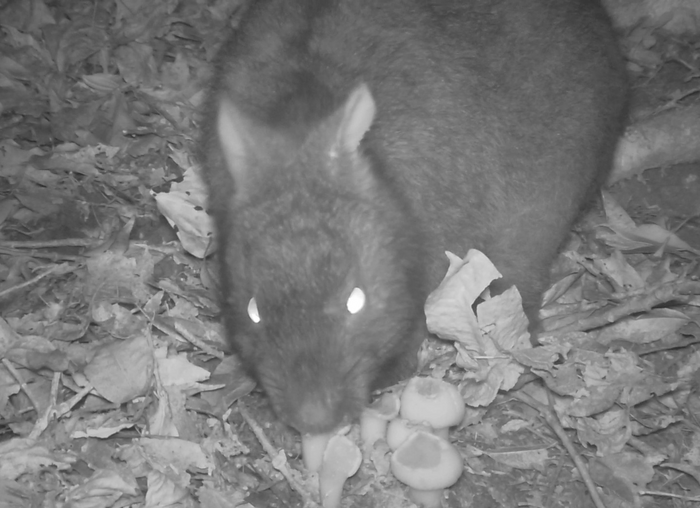Professor Suetsugu Kenji and graduate student Mr. HASHIWAKI Hiromu of Kobe University's Graduate School of Science, have discovered that the endangered Amami rabbit plays a crucial role in the seed dispersal of the non-photosynthetic plant Balanophora yuwanensis.
This revelation sheds new light on the previously unknown ecological function of the world's only dark-furred wild rabbit, considered a flagship species of the Ryukyu Archipelago. Despite being a rare, nocturnal animal that inhabits dense forests on two subtropical islands, little is known about the ecology of the Amami rabbit. These findings will be published in Ecology on January 23, 2023.
The Amami Rabbit is a unique rabbit with a body that measures between 42 and 51 centimeters in length (16.5 - 20 inches) and a tail that ranges from 1 to 3.5 centimeters (0.4 - 1.4 inches) in length. They typically weigh between 2 and 3 kilograms (4.4 - 6.6 lbs). They have bulky bodies, dark brown fur, a pointed nose, small eyes, and short ears. They have short legs and long, curved claws, which they use for digging holes. They communicate with other Amami Rabbits by clicking sounds and calling noises, which is a rarity among rabbits.
Balanophora Plants
The study of seed dispersal is crucial for understanding the evolution and ecology of terrestrial plants. Discoveries of uncommon seed dispersal agents are especially intriguing. The researchers were puzzled about how the non-photosynthetic, mushroom-like Balanophora plants, which have some of the smallest fruits among angiosperms, had their seeds dispersed.
Suetsugu & Hashiwaki discovered that the Amami rabbit plays a key role in seed dispersal for this plant species. They observed feeding marks on Balanophora yuwanensis plants on Amami-Oshima Island in Japan, which they suspected were made by the Amami rabbit. To confirm their hypothesis that the Amami rabbit plays a role in seed dispersal for Balanophora yuwanensis, Suetsugu & Hashiwaki studied the understory of dense forests on Amami-Oshima.
They set up infrared-triggered cameras and observed that the Amami rabbit was the main consumer of B. yuwanensis fruit. Furthermore, all Amami rabbit fecal samples collected in the field contained at least some viable B. yuwanensis seeds, providing strong evidence of the rabbit's role as a seed dispersal agent. Since Balanophora yuwanensis is a host-specific obligate parasite, efficient seed transportation likely requires the seed to be deposited near the roots of a compatible host. The Amami rabbit may facilitate this through digging and defecating underground in burrows.

The Amami rabbit consumed both dry fruits and vegetative tissue from B. yuwanensis. It serves as a dominant seed disperser for B. yuwanensis, incentivized by the fruit and the vegetative tissue.
ALSO READ: Algae-Based Artificial Leaves from 3D Printing May Be Used to Produce Oxygen on Mars
Amami Rabbit as Dispersal Agent
It is intriguing to note that the Amami rabbit is a seed dispersal agent for B. yuwanensis even though the plant produces dry fruits, which are not typically attractive to seed dispersers. The Amami rabbit was observed consuming both dry fruits and vegetative tissue from B. yuwanensis, which is notable as the potential role of rabbits as seed dispersers has largely been overlooked due to their diet of leaves rather than fruits.
However, this study reveals that the Amami rabbit serves as a major seed disperser for B. yuwanensis, driven by its attraction to the plant's vegetative tissue. This research highlights the previously unrecognized ecological role of the endangered Amami rabbit as a seed dispersal agent, suggesting that it may have other functions yet to be discovered.
The Amami rabbit is a rare species found in the forests of two small islands, Amami and Tokunoshima, in southern Japan. The species population is fragmented and currently estimated at around 5,400 individuals, and it is facing a decline due to habitat destruction and predation by introduced mongooses, as well as feral dogs and cats, according to Britannica.
Living Fossils
The Animal Files described these rabbit species as forest dwellers and lived in burrows which they dig themselves, using them as dens and nests. These rabbits are nocturnal and move around the forest through passages in the undergrowth. They feed on forest plants such as pampas grass, sweet potato stems, bamboo shoots, nuts, berries, leaves, acorns, and bark.
Limited information is available about their breeding habits, but it is known that they mate in November or December, and the young are born in burrows. They typically have two litters per year, each with 2-3 young. The Amami Rabbit is often referred to as a living fossil, a surviving remnant of ancient rabbits that once lived on the Asian mainland.
These rabbits became extinct on the mainland but survived on the two small islands where they can still be found today. Historically, Amami Rabbits were hunted by humans, but Japan gave them legal protection in 1921. Unfortunately, their population is quite small, and less than 5,000 Amami Rabbits are estimated to remain.
RELATED ARTICLE: Microalgae Producing Ecofriendly Biofuel, Perfect Alternative For Fossil Fuel
Check out more news and information on Photosynthesis in Science Times.














